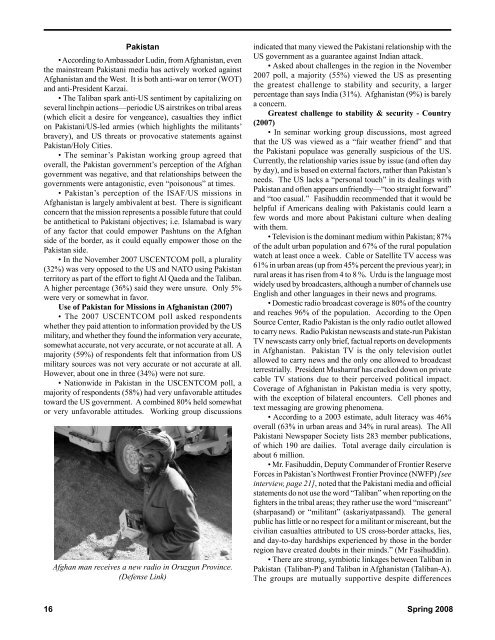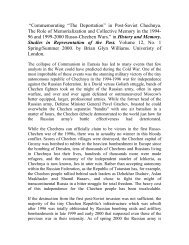Download - IO Sphere
Download - IO Sphere
Download - IO Sphere
Create successful ePaper yourself
Turn your PDF publications into a flip-book with our unique Google optimized e-Paper software.
Pakistan<br />
• According to Ambassador Ludin, from Afghanistan, even<br />
the mainstream Pakistani media has actively worked against<br />
Afghanistan and the West. It is both anti-war on terror (WOT)<br />
and anti-President Karzai.<br />
• The Taliban spark anti-US sentiment by capitalizing on<br />
several linchpin actions—periodic US airstrikes on tribal areas<br />
(which elicit a desire for vengeance), casualties they inflict<br />
on Pakistani/US-led armies (which highlights the militants’<br />
bravery), and US threats or provocative statements against<br />
Pakistan/Holy Cities.<br />
• The seminar’s Pakistan working group agreed that<br />
overall, the Pakistan government’s perception of the Afghan<br />
government was negative, and that relationships between the<br />
governments were antagonistic, even “poisonous” at times.<br />
• Pakistan’s perception of the ISAF/US missions in<br />
Afghanistan is largely ambivalent at best. There is significant<br />
concern that the mission represents a possible future that could<br />
be antithetical to Pakistani objectives; i.e. Islamabad is wary<br />
of any factor that could empower Pashtuns on the Afghan<br />
side of the border, as it could equally empower those on the<br />
Pakistan side.<br />
• In the November 2007 USCENTCOM poll, a plurality<br />
(32%) was very opposed to the US and NATO using Pakistan<br />
territory as part of the effort to fight Al Qaeda and the Taliban.<br />
A higher percentage (36%) said they were unsure. Only 5%<br />
were very or somewhat in favor.<br />
Use of Pakistan for Missions in Afghanistan (2007)<br />
• The 2007 USCENTCOM poll asked respondents<br />
whether they paid attention to information provided by the US<br />
military, and whether they found the information very accurate,<br />
somewhat accurate, not very accurate, or not accurate at all. A<br />
majority (59%) of respondents felt that information from US<br />
military sources was not very accurate or not accurate at all.<br />
However, about one in three (34%) were not sure.<br />
• Nationwide in Pakistan in the USCENTCOM poll, a<br />
majority of respondents (58%) had very unfavorable attitudes<br />
toward the US government. A combined 80% held somewhat<br />
or very unfavorable attitudes. Working group discussions<br />
Afghan man receives a new radio in Oruzgun Province.<br />
(Defense Link)<br />
indicated that many viewed the Pakistani relationship with the<br />
US government as a guarantee against Indian attack.<br />
• Asked about challenges in the region in the November<br />
2007 poll, a majority (55%) viewed the US as presenting<br />
the greatest challenge to stability and security, a larger<br />
percentage than says India (31%). Afghanistan (9%) is barely<br />
a concern.<br />
Greatest challenge to stability & security - Country<br />
(2007)<br />
• In seminar working group discussions, most agreed<br />
that the US was viewed as a “fair weather friend” and that<br />
the Pakistani populace was generally suspicious of the US.<br />
Currently, the relationship varies issue by issue (and often day<br />
by day), and is based on external factors, rather than Pakistan’s<br />
needs. The US lacks a “personal touch” in its dealings with<br />
Pakistan and often appears unfriendly—“too straight forward”<br />
and “too casual.” Fasihuddin recommended that it would be<br />
helpful if Americans dealing with Pakistanis could learn a<br />
few words and more about Pakistani culture when dealing<br />
with them.<br />
• Television is the dominant medium within Pakistan; 87%<br />
of the adult urban population and 67% of the rural population<br />
watch at least once a week. Cable or Satellite TV access was<br />
61% in urban areas (up from 45% percent the previous year); in<br />
rural areas it has risen from 4 to 8 %. Urdu is the language most<br />
widely used by broadcasters, although a number of channels use<br />
English and other languages in their news and programs.<br />
• Domestic radio broadcast coverage is 80% of the country<br />
and reaches 96% of the population. According to the Open<br />
Source Center, Radio Pakistan is the only radio outlet allowed<br />
to carry news. Radio Pakistan newscasts and state-run Pakistan<br />
TV newscasts carry only brief, factual reports on developments<br />
in Afghanistan. Pakistan TV is the only television outlet<br />
allowed to carry news and the only one allowed to broadcast<br />
terrestrially. President Musharraf has cracked down on private<br />
cable TV stations due to their perceived political impact.<br />
Coverage of Afghanistan in Pakistan media is very spotty,<br />
with the exception of bilateral encounters. Cell phones and<br />
text messaging are growing phenomena.<br />
• According to a 2003 estimate, adult literacy was 46%<br />
overall (63% in urban areas and 34% in rural areas). The All<br />
Pakistani Newspaper Society lists 283 member publications,<br />
of which 190 are dailies. Total average daily circulation is<br />
about 6 million.<br />
• Mr. Fasihuddin, Deputy Commander of Frontier Reserve<br />
Forces in Pakistan’s Northwest Frontier Province (NWFP) [see<br />
interview, page 21], noted that the Pakistani media and official<br />
statements do not use the word “Taliban” when reporting on the<br />
fighters in the tribal areas; they rather use the word “miscreant”<br />
(sharpasand) or “militant” (askariyatpassand). The general<br />
public has little or no respect for a militant or miscreant, but the<br />
civilian casualties attributed to US cross-border attacks, lies,<br />
and day-to-day hardships experienced by those in the border<br />
region have created doubts in their minds.” (Mr Fasihuddin).<br />
• There are strong, symbiotic linkages between Taliban in<br />
Pakistan (Taliban-P) and Taliban in Afghanistan (Taliban-A).<br />
The groups are mutually supportive despite differences<br />
16 Spring 2008




